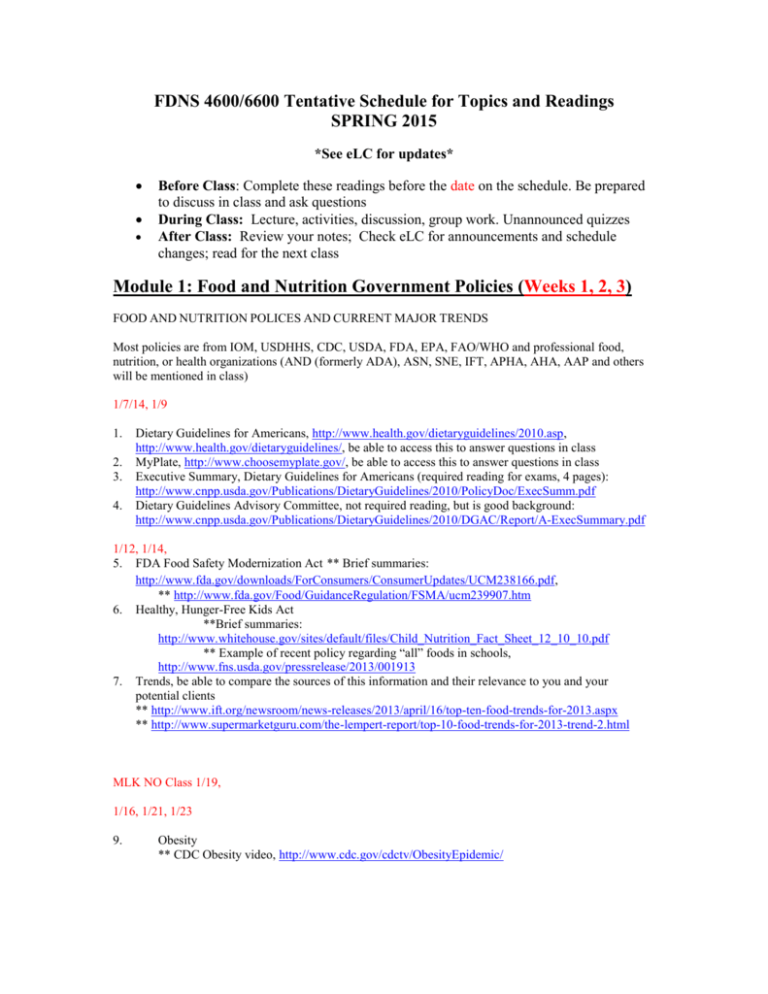ABerg_WeeklySchedule
advertisement

FDNS 4600/6600 Tentative Schedule for Topics and Readings SPRING 2015 *See eLC for updates* Before Class: Complete these readings before the date on the schedule. Be prepared to discuss in class and ask questions During Class: Lecture, activities, discussion, group work. Unannounced quizzes After Class: Review your notes; Check eLC for announcements and schedule changes; read for the next class Module 1: Food and Nutrition Government Policies (Weeks 1, 2, 3) FOOD AND NUTRITION POLICES AND CURRENT MAJOR TRENDS Most policies are from IOM, USDHHS, CDC, USDA, FDA, EPA, FAO/WHO and professional food, nutrition, or health organizations (AND (formerly ADA), ASN, SNE, IFT, APHA, AHA, AAP and others will be mentioned in class) 1/7/14, 1/9 1. 2. 3. 4. Dietary Guidelines for Americans, http://www.health.gov/dietaryguidelines/2010.asp, http://www.health.gov/dietaryguidelines/, be able to access this to answer questions in class MyPlate, http://www.choosemyplate.gov/, be able to access this to answer questions in class Executive Summary, Dietary Guidelines for Americans (required reading for exams, 4 pages): http://www.cnpp.usda.gov/Publications/DietaryGuidelines/2010/PolicyDoc/ExecSumm.pdf Dietary Guidelines Advisory Committee, not required reading, but is good background: http://www.cnpp.usda.gov/Publications/DietaryGuidelines/2010/DGAC/Report/A-ExecSummary.pdf 1/12, 1/14, 5. FDA Food Safety Modernization Act ** Brief summaries: http://www.fda.gov/downloads/ForConsumers/ConsumerUpdates/UCM238166.pdf, ** http://www.fda.gov/Food/GuidanceRegulation/FSMA/ucm239907.htm 6. Healthy, Hunger-Free Kids Act **Brief summaries: http://www.whitehouse.gov/sites/default/files/Child_Nutrition_Fact_Sheet_12_10_10.pdf ** Example of recent policy regarding “all” foods in schools, http://www.fns.usda.gov/pressrelease/2013/001913 7. Trends, be able to compare the sources of this information and their relevance to you and your potential clients ** http://www.ift.org/newsroom/news-releases/2013/april/16/top-ten-food-trends-for-2013.aspx ** http://www.supermarketguru.com/the-lempert-report/top-10-food-trends-for-2013-trend-2.html MLK NO Class 1/19, 1/16, 1/21, 1/23 9. Obesity ** CDC Obesity video, http://www.cdc.gov/cdctv/ObesityEpidemic/ ** Children’s Food Environment State Indicator Report, http://www.cdc.gov/obesity/downloads/ChildrensFoodEnvironment.pdf, know the key environmental indicators and how Georgia compares to other states and nationally 10. Food insecurity ** http://www.ers.usda.gov/publications/err-economic-researchreport/err155.aspx#.UsXPw7SOcmY, read the summary report at http://www.ers.usda.gov/ersDownloadHandler.ashx?file=/media/1183204/err-155-reportsummary.pdf 11. Food-borne illness ** http://www.cdc.gov/foodborneburden/2011-foodborne-estimates.html Module 2: Regulations and Food Labeling (Weeks 4, 5, 6) 1/26, 1/28, 1/30 1. What is a processed food?** http://www.foodinsight.org/LinkClick.aspx?fileticket=wtg018sd8qk%3d&tabid=1 398 2. Regulations at a Glance (compares foods, supplements, drugs), CRN,** Read the Q&A and the chart: http://www.crnusa.org/leg_glance.html 3. Snapshot of Food Safety Milestones in the History of the FDA http://www.fda.gov/NewsEvents/PublicHealthFocus/ucm238505.htm 4. Front-of-Package Rating Systems and Symbols, Institute of Medicine (along with FDA, CDC, and USDA) **http://www.iom.edu/~/media/Files/Report%20Files/2011/Front-of-PackageNutrition-Rating-Systems-and-Symbols-Promoting-HealthierChoices/frontofpackagereportbrieffornap.pdf 5. Food Labeling Guide, Health Claims, FDA, appendices A, B, C, D, and F – we’ll identify the required areas in class**http://www.fda.gov/food/guidanceregulation/guidancedocumentsregulator yinformation/labelingnutrition/ucm2006828.htm 2/2, 2/4 Food Allergy and Asthma 6. ** The changing CARE for patients with food allergy, http://download.journals.elsevierhealth.com/pdfs/journals/00916749/PIIS0091674912018258.pdf 7. IFIC, Food Insight, Background on Food Allergies and Asthmahttp://www.foodinsight.org/Resources/Detail.aspx?topic=Background_on_Fo od_Allergies_and_Asthma 8. Food Allergy Among U.S. Children: Trends in Prevalence and Hospitalizations, CDC** http://www.cdc.gov/nchs/data/databriefs/db10.pdf EXAM 1: Friday 2/6/14 2/9, 2/11 FUNCTIONAL FOODS 9. WebMD Functional Foods** http://www.webmd.com/video/functional-foods 10. International Food Information Council** http://www.foodinsight.org/Content/3842/Final%20Functional%20Foods%20Backgrounder.pdf 11. IFIC functional foods chart http://www.foodinsight.org/Content/6/FINAL-IFIC-Fndtn-Functional12. Foods-Backgrounder-with-Tips-and-changes-03-11-09.pdf Position of the American Dietetic Association: functional foods (2013)** http://www.eatright.org/About/Content.aspx?id=8354 click the “PDF” or use www.libs.uga.edu 2/11: PROJECT INTRODUCED; MID-TERM EVALUATION 2/13, 2/16, 2/18, 2/20 SUPPLEMENTS 13. FDA Q & A on Dietary Supplements (2013 new)** http://www.fda.gov/Food/DietarySupplements/QADietarySupplements/default.htm 14. ASHP Statement on the Use of Dietary Supplements ** http://www.ashp.org/DocLibrary/BestPractices/SpecificStDietSuppl.aspx or www.libs.uga.edu 15. Contamination and adulteration of herbal medicinal products (HMPs): an overview of systematic 16. 17. reviews: http://link.springer.com/article/10.1007%2Fs00228-012-1353-z US Preventive Services Task Force Draft Recommendations in 2013: www.uspreventiveservicestaskforce.org/bulletins/vitadraftbulletin.pdfhttp://annals.org/data/Journa ls/AIM/929454/0000605-201312170-00008.pdf Not required – the complete report: http://www.ncbi.nlm.nih.gov/books/NBK173987/ Vitamin E increases prostate cancer in men, JAMA (abstract), http://www.ncbi.nlm.nih.gov/pubmed/21990298 18. Cancer risk with folic acid supplements: a systematic review and meta-analysis (abstract): http://www.ncbi.nlm.nih.gov/pubmed/22240654 Module 3: The Science Behind the Policies (Week 7) 2/23 UNDERSTANDING FOOD AND NUTRITION RESEARCH 1. 2. How to Understand and Interpret Food and Health-related Scientific Studies, IFIC, ** http://www.foodinsight.org/LinkClick.aspx?fileticket=d8IZK7B4MGY%3D&tabid=93 Echinacea as an example: Taylor et al., http://jama.ama-assn.org/cgi/reprint/290/21/2824 2/25, 2/27 SWEETENERS AS AN EXAMPLE 1. ** Use of nutritive and nonnutritive sweeteners, Academy of Nutrition and Dietetics,http://www.eatright.org/About/Content.aspx?id=8363&terms=position+sweeteners (click on PDF) 2. ** Stevia: What refined Stevia preparations have been evaluated by FDA to be used as a sweetener? http://www.fda.gov/AboutFDA/Transparency/Basics/ucm214865.htm Module 4: Food Additives (Weeks 8, 9 (Spring Break), 10) 3/2, 3/4, FAT REPLACERS AND SUBSTITUTES AND FAT REDUCTION INGREDIENTS 3. IFIC Background on Dietary Fats and Fat Replacers http://www.foodinsight.org/Resources/Print.aspx?topic=Background_on_Dietary_Fats_and_Fat_R eplacers_ 4. Calorie Control Council, Glossary of Fat Replacers http://www.caloriecontrol.org/articles-andvideo/feature-articles/glossary-of-fat-replacers 5. ** FDA, http://www.fda.gov/food/ingredientspackaginglabeling/foodadditivesingredients/ucm094211.htm* * Salt, http://www.cdc.gov/Salt/pdfs/Salt_Stats_Media.pdf, ** Allergies and sulfite sensitivities, WebMD, http://www.webmd.com/allergies/guide/sulfite-sensitivity 3/6 NITRITES AND N-NITROSO COMPOUNDS AND RELATED ISSUES 6. ** Hord NG, Tang Y, Bryan NS. Food sources of nitrates and nitrites: the physiologic context for potential health benefits. Am J Clin Nutr. 2009 Jul;90(1):1-10. http://ajcn.nutrition.org/content/90/1/1.full.pdf (we’ll review in class and identify the focus areas) SPRING BREAK! 3/9, 3/11, 3/13 3/16, 3/18 FLAVORS 7. ** Adams TB, Smith RL. Issues and challenges in the safety evaluation of food flavors. Toxicology Letters. 2004 Apr 1;149(1-3):209-13. Review. www.libs.uga.edu or www.sciencedirect.com COLORS 8. ** FDA list of colors, http://www.fda.gov/forindustry/coloradditives/coloradditiveinventories/ucm115641.htm (only for FOOD) 9. ** How Safe Are Color Additives? FDA, http://www.fda.gov/ForConsumers/ConsumerUpdates/ucm048951.htm 10. ** Q & A about Food and Color Additives, FDA (review all of the questions about colors) http://www.fda.gov/Food/IngredientsPackagingLabeling/FoodAdditivesIngredients/ucm0 94211.htm#qa 3/20 MSG 11. Williams, Woessner. Monosodium glutamate “allergy”: menace or myth? Clinical & Experimental Allergy, 39, 640-646, 2009. Obtain through www.libs.uga.edu or http://onlinelibrary.wiley.com/doi/10.1111/j.1365-2222.2009.03221.x/pdf 12. Zhou Y, Yang M, Dong BR. Monosodium glutamate avoidance for chronic asthma in adults and children. Cochrane Database Syst Rev. 2012 Jun 13;6:CD004357, abstract: http://onlinelibrary.wiley.com/doi/10.1002/14651858.CD004357.pub4/pdf/abstract Module 4: Controversies (Week 11, 12, 13, 14, 15) 3/23 RED MEAT, PROCESSED MEATS, OTHER FOODS AND CANCER 1. ** WCRF, AICR, know the recommendations related to meat and processed meats, http://www.dietandcancerreport.org/expert_report/recommendations/index.php 3/25 SOY AND HEALTH 2. Effects of soy on health outcomes, AHRQ ** http://archive.ahrq.gov/clinic/epcsums/soysum.pdf (getting old, but a very good place to start with learning about soy and health) 3/25 DIET AND HYPERACTIVITY 3. ** Hurt EA, Arnold LE, Lofthouse N. Dietary and nutritional treatments for attentiondeficit/hyperactivity disorder: current research support and recommendations for practitioners. Curr Psychiatry Rep. 2011 Oct;13(5):323-32, abstract, http://www.ncbi.nlm.nih.gov/pubmed/21779824 (general good nutrition may be beneficial). EXAM 2: 3/27/14 3/30, 4/1 BIOTECHNOLOGY AND GMO LABELING OF FOOD 4. 5. 6. USDA, FNIC, http://fnic.nal.usda.gov/consumers/all-about-food/food-biotechnology (go to this link and then click on links below): ** USDA, http://www.usda.gov/wps/portal/usda/usdahome?navid=BIOTECH&parentnav=AGRICULTURE &navtype=RT ** ACSH, http://acsh.org/2000/09/biotechnology-and-food-second-edition/ (1 page summary) 4/3, 4/6 COFFEE AND CAFFEINE 7. ** Higdon JV, Frei B. Coffee and health: a review of recent human research. Crit Rev Food Sci Nutr. 2006;46(2):101-23. Review. Pubmed at http://www.ncbi.nlm.nih.gov/entrez/query.fcgi 8. ** FDA Energy Drinks and Supplements: Investigations of Adverse Event Reports, 2012, http://www.fda.gov/Food/NewsEvents/ucm328536.htm 9. FDA Serious Concerns Over Alcoholic Beverages with Added Caffeine, Note: Be able to identify why FDA, CDC are concerned, what actions are being taken, and how you will use this information; questions will be on the exam concerning this information 10. ** http://www.fda.gov/ForConsumers/ConsumerUpdates/ucm233987.htm 11. ** After this link, also review the next 5 links on this page 12. CDC Fact Sheets – Caffeinated Alcoholic Beverages** http://www.cdc.gov/alcohol/factsheets/cab.htm 4/8 MERCURY AND FISH 13. ** What You Need to Know About Mercury in Fish and Shellfish, EPA and FDA http://www.fda.gov/Food/FoodborneIllnessContaminants/BuyStoreServeSafeFood/ucm110591.htm 4/10, 4/13 PESTICIDES 14. ** What is a pesticide? EPA, http://www.epa.gov/pesticides/about/ 15. ** Pesticides and food: What you and your family need to know, EPA, http://www.epa.gov/pesticides/food/ (read first 8 bulleted points of information to the right) 16. ** Agriculture Health Study, http://aghealth.nci.nih.gov/ (specific readings will be selected) 4/15 CLIMATE CHANGE AND FOOD PRODUCTION 1. ** Carlsson-Kanyama A, González AD. Potential contributions of food consumption patterns to climate change. Am J Clin Nutr. 2009 May;89(5):1704S1709S, http://www.ajcn.org/cgi/content/abstract/89/5/1704S Obtain through www.libs.uga.edu 4/17, 4/20 ORGANIC FOOD & RELATED TOPICS – THESE LINKS ARE BROKEN 2. 3. 4. ** USDA/ERS Organic Food, http://www.ers.usda.gov/topics/natural-resourcesenvironment/organic-agriculture.aspx#.U1Qq5VfeSz4 (specific readings will be selected) ** Organic Trade Association, http://www.ota.com/organic/mt.html (specific readings will be selected) ** WebMD, http://www.webmd.com/video/eating-organic, http://www.webmd.com/diet/video/best-organic-foods 4/22 KAVA 1. 2. 3. 4. ** Saeed SA, Bloch RM, Antonacci DJ. Herbal and dietary supplements for treatment of anxiety disorders. Am Fam Physician. 2007 Aug 15;76(4):549-56. Review. http://www.aafp.org/afp/20070815/549.pdf ** Pittler MH, Ernst E. Kava extract for treating anxiety. Cochrane Database Syst Rev. 2002;(2):CD003383. Review. Update in: Cochrane Database Syst Rev. 2003;(1):CD003383. http://www.mrw.interscience.wiley.com/cochrane/clsysrev/articles/CD0033 83/frame.html ** FDA, Letter to health-care professionals: FDA issues consumer advisory that kava products may be associated with severe liver injury. Rockville, Maryland: U.S. Department of Health and Human Services, Food and Drug Administration, 2002,http://www.fda.gov/Food/ResourcesForYou/Consumers/ucm085482.htm ** CDC, Hepatic toxicity possibly associated with kava-containing products—United States, Germany, and Switzerland, 1999-2002. MMWR Morb Mortal Wkly Rep. 2002 Nov 29;51(47):1065-7, http://www.cdc.gov/mmwr/preview/mmwrhtml/mm5147a1.htm. EXAM 3: 4/27 Final Exam: Project sharing and reflection







